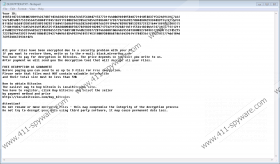Oled Ransomware Removal Guide
Oled Ransomware is yet another infection that employs AES (Advanced Encryption Standard) to corrupt your files. This infection reconstructs your files in a way that they become unreadable. To restore them back to normal, a special key is needed, and, of course, the creator of the ransomware uses it to coerce victims into making huge payments. These are identified as ransoms because something that belongs to the victim (in our case, it is the personal files) is held hostage in the hopes of receiving a payment. Needless to say, this is why this infection is classified as a ransomware. Unfortunately, more and more threats of this kind emerge every single day, and some of them include Deos Ransomware, Mancros Ransomware, and Thundercrypt Ransomware. In some cases, malicious infections only pose as ransomware to trick users into giving up their savings. Due to this, you should first check if your files were encrypted when you encounter ransomware. Unfortunately, the threat we are discussing in this report can encrypt data, and you cannot overrule that by deleting Oled Ransomware.
According to our research, the executable of Oled Ransomware is most likely to be introduced to you via a misleading spam email, and you are likely to be tricked into executing it yourself. This is not surprising, considering that most ransomware infections are spread in this deceptive manner. As soon as the threat is in, it creates a copy in the %APPDATA% directory, as well as the point of execution entry in Windows Registry at HKCU\Software\Microsoft\Windows\CurrentVersion\RunOnce. Immediately after that, the infection begins encrypting files, and it should go after the files stored in %USERPROFILE% and %HOMEDRIVE% directories. Needless to say, the infection does not encrypt system files because the infection cannot run if the PC is crashing. That being said, the threat can encrypt EXE files, which means that the applications you have downloaded onto your PC could crash, and they might include anti-malware software and browsers. To help you identify the encrypted files quickly, the infection attaches the monstrous “.[black.mirror@qq.com].oled” extension to their names. Unfortunately, it is very likely that you will find personal photos, documents, archives, and other sensitive data encrypted.
Oled Ransomware creates a file called “DECRYPTION.TXT” after the encryption is complete. Although the original location of this file is %USERPROFILE%, it is copied to every folder containing encrypted files. This TXT file is the main instrument for cyber criminals to communicate with you. When you open this file – and that is completely safe to do – you are provided with an email address (black.mirror@qq.com) using which you are expected to contact the creator of Oled Ransomware. It also mentions that a ransom paid in Bitcoins is expected as well, but the exact sum is not revealed. It is suggested that that depends on how quickly you email cyber criminals, which means that this is how you get more information about the payment in general. The message also informs that any attempts to remove the infection or use third-party decryption software can result in the loss of files, but that is just a scare tactic to follow the instructions.
Since the devious Oled Ransomware works in the background, it can encrypt the files that you place on the PC after the encryption takes place. Unfortunately, it is possible that the EXE file of the chosen anti-malware tool will be encrypted before it can find and remove Oled Ransomware itself. Needless to say, that can create issues when eliminating this infection. However, if you kill the malicious process – as shown in the first steps in the instructions below – you should be able to download and execute any software. Even if you choose to proceed with manual removal, installing anti-malware software is very important. If any malicious leftovers are still active, this software will take care of them. More important, it will help you protect your operating system in the future. Of course, you have to do your part as well. Do not open random spam emails, install unfamiliar software, click on suspicious links, or do other things that might open up security backdoors.
How to delete Oled Ransomware
- Simultaneously tap Ctrl+Shift+Esc to launch Task Manager.
- Click the Processes tab and identify the malicious [random name] process (could be 1sv_host.exe).
- Right-click the process and choose Properties.
- Copy the location of the file this process represents. Click Cancel.
- Select the process and click End task/End process and then exit the tool.
- Simultaneously tap Win+E to launch Windows Explorer.
- Paste the location of the malicious [random name].exe file.
- Right-click and Delete the file.
- Enter %APPDATA% into the bar at the top.
- Right-click and Delete the copy of [random name].exe file.
- Enter %USERPROFILE% into the bar at the top.
- Right-click and Delete the ransom file called DECRYPTION.TXT (note that the copies must be deleted as well).
- Simultaneously tap Win+R to launch RUN and enter regedit.exe to launch Registry Editor.
- Navigate to HKEY_CURRENT_USER\Software\Microsoft\Windows\CurrentVersion\Run.
- Right-click and Delete the [random name] value whose value data points to the ransomware.
- Navigate to HKEY_CURRENT_USER\Software\Microsoft\Windows\CurrentVersion\RunOnce.
- Repeat step 15.
- Empty Recycle Bin to get rid of the malicious components.
- Perform a full system scan using a legitimate malware scanner to look for leftovers.
Oled Ransomware Screenshots:


